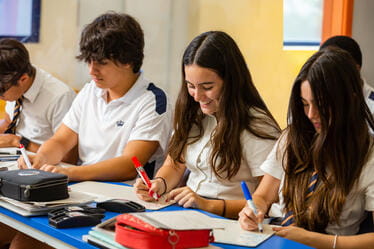We use cookies to improve your online experiences. To learn more and choose your cookies options, please refer to our cookie policy.



There is something remarkably special about international schools. I am not talking about the smart uniforms, the IB curriculum or the ever-present English language. They are special and unique places, micro worlds in themselves, because of the kaleidoscopic social fabric they are made of, their children!

A person simply needs to walk along the corridors of an international school like BCB to hear and see children, but also teachers, teaching assistants and operational staff that all come from a variety of places, cultures and backgrounds, all under the same (physical or virtual!) roof .
There are children who are thousands of miles away from their birth country, local children who have travelled since the day they were born, and children who belong to the so-called three culture generation (whose parents come from two different countries and currently live in a 3rd country). There are children who speak 4 languages fluently and children whose life and background are simply too complex and rich to be labeled by one single nationality or restricted to the place where their passports were issued. There are children who see their grandparents regularly and children who hop from continent to continent to visit their extended family during their holidays. ‘Where do these children come from?’ and ‘Where are they going next?’, are questions that cannot be answered with single words or a specific geographic location.
This cultural and social richness is a precious gift we must not take for granted.
Whilst less internationally oriented colleagues might have a horrified look on their faces when I tell them I teach a class of children where seven different languages are spoken, in addition to English, I believe rather the opposite, the diversity of my class, and of the whole school, is, in fact, an invaluable asset and an exceptional source of inspiration.
As we still witness countless minorities around the world facing challenges based on the colour of their skin, their gender, the language they speak or their faith, I believe we can all learn a crucial lesson from observing how well children of different ethnicities, religions and social backgrounds coexist in harmony within the same environment in our school.

When children play with each other, sit next to each other, or have playdates without questioning each other’s origin or differences, they, in fact, offer a brilliant example of tolerance, respect for diversity and openness we should all take as a model.
Even speaking completely different languages is not a high enough barrier for children who want to interact, as they often find ways of communicating that go beyond simple grammar rules and accents.
It is extremely inspiring for us to observe how differences and potential contrasts are not simply ignored by children, but rather accepted. But in addition to that, as adults, we also have the challenging responsibility to preserve that acceptance as children grow and have encounters with racism, sexism and inequalities. This is part of our job as educators or parents and it is not always simple and straightford, but how rewarding are the fruits of that labour, and how crucial for our future society!
When people look at the years to come and predict a bleak and gloomy future, I strongly disagree. We have our future in front of us and it is incredibly wonderful in its diversity, inclusion and complexity. All we have to do is preserve it and help it flourish.
Francesca Facciani - Head of EYFS, CF Campus.